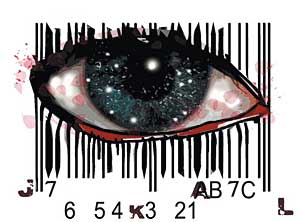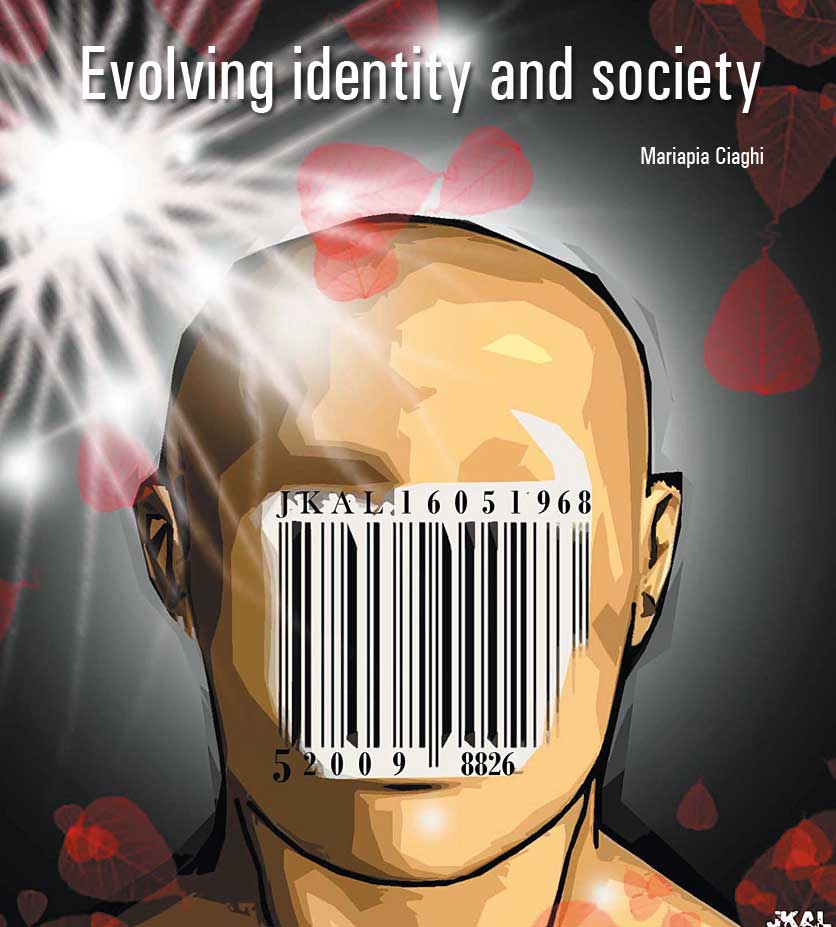 Identity is a basic need of the human being. Erich Fromm said: “The need for a feeling of identity is so vital and imperative that Man cannot be healthy if he can’t find some means of satisfying it.” According to Fromm’s idea, identity is an affective need (“sentiment”), a cognitive need (“knowledge of oneself and of one’s relations as different people”) and an active need (the human being must “take decisions” making use of his own freedom and will). Identity is derived from the personality, and therefore identity is to do with our life stories, our ineluctable and unalterable heritage, which will be influenced by the concept of the universe which is most familiar to us, the phenotype originating from the world that predominates in the time and place in which we live. An ideogram therefore arises showing a crucible into which flow the reality of the social medium on the one hand, and personal history on the other. One could say that identity evolves and undergoes a process of constant change, which implies an affirmation of particularity, but also differences and relations which illustrate the value and the dimension of a common age-group. This is an everpresent question, the answer to which will be found in images, fragments, memories, stories and interpersonal relationships, so that identity is nothing but the result of the set of identifications that a person makes in the course of his own personal history. When some say that here or there we find crises of identity, I say that these ar Identity is a basic need of the human being. Erich Fromm said: “The need for a feeling of identity is so vital and imperative that Man cannot be healthy if he can’t find some means of satisfying it.” According to Fromm’s idea, identity is an affective need (“sentiment”), a cognitive need (“knowledge of oneself and of one’s relations as different people”) and an active need (the human being must “take decisions” making use of his own freedom and will). Identity is derived from the personality, and therefore identity is to do with our life stories, our ineluctable and unalterable heritage, which will be influenced by the concept of the universe which is most familiar to us, the phenotype originating from the world that predominates in the time and place in which we live. An ideogram therefore arises showing a crucible into which flow the reality of the social medium on the one hand, and personal history on the other. One could say that identity evolves and undergoes a process of constant change, which implies an affirmation of particularity, but also differences and relations which illustrate the value and the dimension of a common age-group. This is an everpresent question, the answer to which will be found in images, fragments, memories, stories and interpersonal relationships, so that identity is nothing but the result of the set of identifications that a person makes in the course of his own personal history. When some say that here or there we find crises of identity, I say that these ar e crises in the order established by others, since identity is not in crisis, but rather undergoing movement or transformation, representing the natural product of the individual inserted into society. Identities move from one place to another, and can change,if necessary, many many times, so that subjects inside such changes encounter and enter into connection with other symbolic codes. Thus it is necessary to pass to the plane of collective identity on two levels; positional identity and identity as strategy. The position of a subject inside the social ambit is defined by the place he occupies in various fields, from the distribution of power in some space and from the capital (economic, cultural, social and symbolic) he possesses. From this we can derive the importance of understanding the social background of the nexus of social changes which are allowing the appearance of new social subjects, new forms of behaviour and thought and, therefore, new challenges for the projects of democracy and citizenship. The recognition of identity as such is linked to legitimacy and power of groups in contact with each other. For this reason, the recognition of identity is a social conflict, since not all groups have the same power of recognition of their own identities, and only those with authority and legitimate power have the capacity to impose their own definitions of themselves and of others. Thestrategy of identification is defined by the capacity to reach goals, or to find resources for action directed towards recognition and autonomy. Identity as mediation appears as a symbolic e crises in the order established by others, since identity is not in crisis, but rather undergoing movement or transformation, representing the natural product of the individual inserted into society. Identities move from one place to another, and can change,if necessary, many many times, so that subjects inside such changes encounter and enter into connection with other symbolic codes. Thus it is necessary to pass to the plane of collective identity on two levels; positional identity and identity as strategy. The position of a subject inside the social ambit is defined by the place he occupies in various fields, from the distribution of power in some space and from the capital (economic, cultural, social and symbolic) he possesses. From this we can derive the importance of understanding the social background of the nexus of social changes which are allowing the appearance of new social subjects, new forms of behaviour and thought and, therefore, new challenges for the projects of democracy and citizenship. The recognition of identity as such is linked to legitimacy and power of groups in contact with each other. For this reason, the recognition of identity is a social conflict, since not all groups have the same power of recognition of their own identities, and only those with authority and legitimate power have the capacity to impose their own definitions of themselves and of others. Thestrategy of identification is defined by the capacity to reach goals, or to find resources for action directed towards recognition and autonomy. Identity as mediation appears as a symbolic  reference, from which denunciation of a certain social denomination arises. The social actors dispose of some parameters for manoeuvre to use elements of identity in a strategic manner. In this sense, many social groups in our society use elements of their own identities as a strategy allowing them to reach their own goals. Starting from this approach, we should not invent a series of cultural elements to define an identity, although it is necessary to show which criteria have been selected and used by members of the group to affirm and distinguish themselves, but rather show which strategies have been used. It is not, therefore, necessary to see what is the ‘true identity’, but rather to explain the processes of identification without judging them. If we recognise that identities are social constructions, we should then ask ourselves the following questions: how, why, for what purpose and with whom are these identities presented and reproduced? Identity, like ethnicity, the nation and even ideology are therefore socio-cultural constructs which social actors constantly modify on the basis of an adaptability which is not however synonymous with convenience. reference, from which denunciation of a certain social denomination arises. The social actors dispose of some parameters for manoeuvre to use elements of identity in a strategic manner. In this sense, many social groups in our society use elements of their own identities as a strategy allowing them to reach their own goals. Starting from this approach, we should not invent a series of cultural elements to define an identity, although it is necessary to show which criteria have been selected and used by members of the group to affirm and distinguish themselves, but rather show which strategies have been used. It is not, therefore, necessary to see what is the ‘true identity’, but rather to explain the processes of identification without judging them. If we recognise that identities are social constructions, we should then ask ourselves the following questions: how, why, for what purpose and with whom are these identities presented and reproduced? Identity, like ethnicity, the nation and even ideology are therefore socio-cultural constructs which social actors constantly modify on the basis of an adaptability which is not however synonymous with convenience.
|
